Art/Form: Fulci's Brush with Death
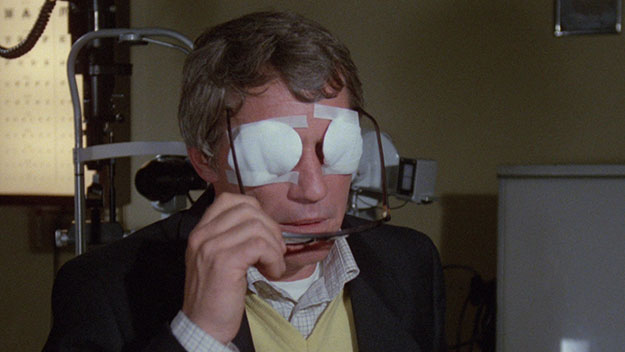
Manhattan Baby
In Lucio Fulci’s 1982 film Manhattan Baby, an archaeologist is blinded while on a dig in Egypt. At the same time, his young daughter receives a cursed amulet from a ghostly figure who is also blind. The family returns to New York with the cursed amulet, and numerous Poltergeist-esque moments of time-, space-, and credulity-defying horror ensue—closet doors lead to a desert on the other side of the world, babysitters disappear, and taxidermically preserved birds come to life and kill.
Fairly standard horror happenings, some might say, but hanging on the walls of the family apartment, where most of the head-scratching horror takes place, is something less expected: the paintings of Italian artist Mario Schifano. They appear in what seem like quite coincidental ways, at the edge of the frame, the innocuous property of the characters within the fiction of the film.
Schifano, who died in 1998, was an avant-garde painter, filmmaker (he devoted one of his experimental shorts to fellow Italian cinematic radical Marco Ferreri), and musician. His work was shown in New York alongside Robert Rauschenberg and Jasper Johns at the Sidney Janis Gallery’s controversial “New Realists” exhibition. In the 1960s Schifano turned to screen-printed Pop Art, influenced by Franz Kline and Jim Dine (whose Pop Art paintings appear in Elio Petri’s 1968 mod-giallo, A Quiet Place in the Country). His work is not exactly what one would expect in the Upper West Side apartment of an archeologist with two kids in the early ’80s, and hardly what one would expect in a Fulci movie.
Fulci gained notoriety with films like The Beyond (1981), House by the Cemetery (1981), City of the Living Dead (1980), and his best-known work outside of Italy, Zombie (1979). He established himself in the U.S. as the basest of gore-mongers and—second only to George A. Romero—a leading architect of the zombie genre. Fulci’s cinematic contributions include an underwater fight between a zombie and a shark (Zombie), a young woman whose entrails pour from her mouth (City of the Living Dead), a man’s face devoured by tarantulas (The Beyond) , and a panoply of eye-focused attacks (more on that later). In terms of socially acceptable transgression, writing, “I love the films of Dario Argento” on an online dating profile might be a cute idea, but it’s still probably best to leave out Fulci.
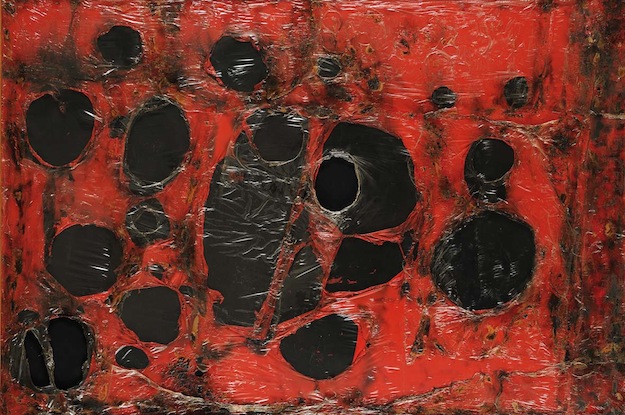
Rosso Plastica M3
Last year, a series of Fulci’s films and several exhibitions of postwar Italian painting coincided on New York’s cultural calendar. Shows of Schifano’s work and that of several other figures in the Italian avant-garde of that period, such as Alighiero Boetti, Giulio Paolini, Alberto Burri, and Fabio Mauri, colonized uptown art galleries. Downtown at Anthology Film Archives, the Italian film programming collective Malastrana presented “Lucio Fulci: Genre Terrorist,” an October showcase of 15 films by the Italian director. Though it’s safe to say there was little overlap in the crowds viewing the post-war paintings and those reveling in grindhouse gore, the two seemingly distant bodies of work bear a number of distinct points of comparison and reference.
In The Beyond alone, the evocations of post-war Italian painting are numerous. The corpses that walk the hospital halls in the film’s climax, in hospital gowns and bandages, echo Italian-American artist Salvatore Scarpitta’s somber “extramurals” such as the 1958 work Matrimonio segreto (Secret Marriage), in which a canvas is stretched across the frame giving the impression of something lurking just beneath its coarse, bandage-like white surface. The melted faces in the film evoke Burri’s texturally extreme canvases, most notably his Rosso Plastica series, and there is a strong affinity between Schifano’s early impasto works and Fulci’s texturally obsessed films.
Both impasto painting and the gore film can “pass” for strictly representational art, but what makes them unique is their overwhelming concern with material. The impasto technique itself, which entails layering paint on a canvas so thickly that it can appear to be emerging from the canvas, resembles the effects of movie carnage, which can seem to flow off the screen. In many ways, Fulci’s work has more to do with the visceral manipulation of materials favored by postwar Italian painters than it does with the narrative fantasies of his predecessors (Mario Bava) and contemporaries (Dario Argento).
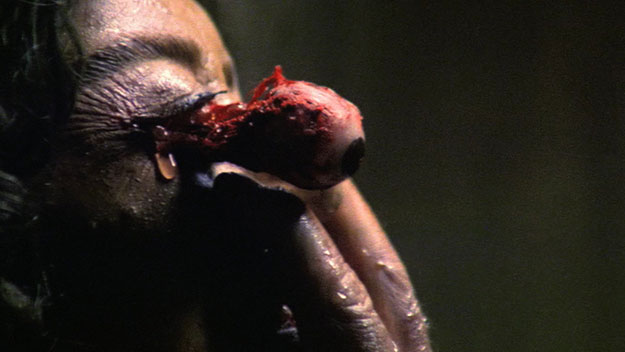
The Beyond
It’s no coincidence that Fulci (affectionately dubbed “the maestro” by fans) might have seen the developments in post-war Italian art as presenting possibilities for film. Before entering the Centro Sperimentale di Cinematografia in Rome, Fulci wrote art criticism (and like Alberto Burri, studied to be a medical doctor) for Gazzetta delle Arti and Rome’s The Messenger (Il Messaggero). He joined il Gruppo Arte Sociale, a critical art group founded by painters including Renzo Vespignani, who worked as production designer on Elio Petri’s 1961 thriller The Assassin. Vespignani’s paintings, notably la peste from the illustrated 1963 edition of Boccacio’s The Decameron, with its rotting corpse replete with gaping chest cavity, could easily be images ripped from Fulci’s Zombie or The Beyond.
In fact, fine art has permeated Italian cinema, and horror in particular, since Giovanni Pastrone’s 1914 silent epic Cabiria and Enrico Guazzoni’s Quo Vadis (1913). Eugenio Bava, the father of arguably the most influential figure in Italian horror of all time, Mario Bava (who recently enjoyed a nearly complete retrospective at the Quad Cinema including the newly restored 1966 film Kill Baby Kill), was a sculptor by trade who found his way into the cinema, photographing Quo Vadis and creating special effects for Cabiria. Father and son collaborated in Mario’s Black Sabbath (1963): Eugenio sculpted the terrifying, contorted face of the old woman’s corpse in the film’s first, iconic sequence. There, in the film’s most frightening moment, Eugenio’s sculptural work reaches beyond the frame and scares the hell out of the viewer. Mario was both technician and artist and his skill with lighting represents the apex of pre-Fulci painterliness in Italian horror. The sculptural black and white of Black Sunday and I Vampiri (1957) and the hallucinatory Pop images of Black Sabbath, Twitch of the Death Nerve (1971), and Hercules in the Haunted World (1961)—the comic book panels awash in sumptuous purples, reds, greens, and blues (a style Argento would later inherit)—are unmatched in the horror genre.
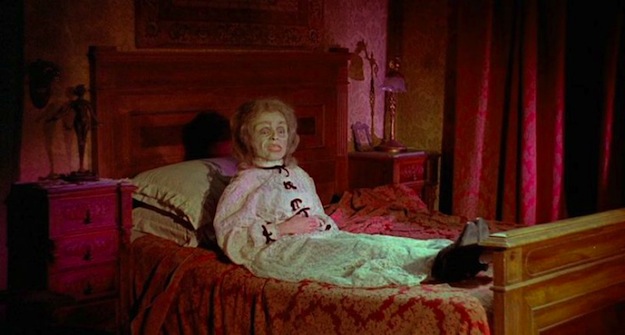 Black Sabbath
Black Sabbath
Fulci paints not simply with light and balanced compositions but sculpturally with materials like blood, brains, eyes, slime, maggots, and entrails. City of the Living Dead takes this to the extreme with a blob of what can maybe be best described as “nastiness” laying on the ground, undulating. This pure expression of textural horror nearly breaks the diegesis of the film with its presence. As a testament to the power of such a dreadfully primordial substance, victims are turned into zombies not by a bite on the neck or shoulder, but by having the shapeless mass of wriggling goo shoved into their faces. Similarly, in Zombie, a rotted corpse slowly emerges from its grave with its eyeless face rotted and filled with worms. There is no identity, no perceivable humanity (or only enough to be unsettling)–just a ghastly, highly detailed sculpture, as psychically affecting and alien as Burri’s melted plastic and Scarpitta’s “extramurals.”
Similarly, Arte Povera, the leading art movement in Italy in the ’60s, in particular made a point of using common or industrial materials to create avant garde installations or canvas. Giving expression to psychological trauma through the manipulation and brutalization of materials was essential in this new work. The Guggenheim exhibition “Albert Burri: The Trauma of Painting” for instance, presented ideas of suffering, damage, and distress with a collection of Burri’s large-scale abstractions, which resemble gaping wounds fashioned out of melted and torn plastic, burlap, and PVC adhesives.
Of course, painting holds a significant place in some of Italy’s greatest “high art” films of the post-war period too. Film historian and critic Miram Liehm has drawn a connection between Burri’s post-war industrial landscapes and the bleak existential terrain presented in Antonioni’s Red Desert. Federico Fellini’s La Dolce Vita (1960) uses Giorgio Morandi’s seemingly quaint, but unsettling still lives to express the gap between the tranquil surface of bourgeois life and the psychic storm which rages below. Italy’s historical tradition of painting coupled with its complex post-fascist identity found expression in horror as well in films like Bava’s Lisa and the Devil (1973) and Pupi Avati’s House with Laughing Windows (1976). Both films count large frescos as key plot elements. The paintings point toward the glory of Italy’s artistic past, but also hint at the suffocating weight of history for the contemporary Italian.
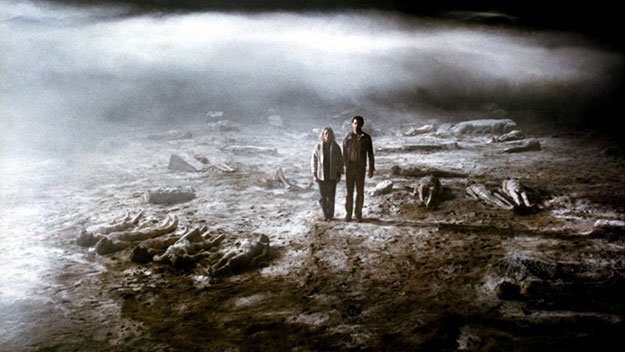
The Beyond
The narrative place of painting in Fulci’s films, however, is in the present. In The Beyond, the “beyond” of the title is represented in a painting we witness being completed, which loosely frames the film. The painting is a somber, surreal landscape (part desert, part moonscape) filled with mounds, which are later revealed to be tortured human forms. The work, a muted psychodrama, brings to mind the canvases of the Italian proto-Surrealist Giorgio de Chirico in its dreamlike bleakness. The painting’s author is rewarded for his ghastly work by being crucified and doused with acid until his face melts into a Burri-like mess. His canvas represents a threat dangerous enough to the established social and aesthetic order to incite a violent reaction. In City of the Living Dead we see another painting-in-progress of a rhinoceros’ eye—bringing the viewer back to Fulci’s dual obsessions: texture and the eye.
The eye, nestled in its protective socket, is a point of vulnerability for human beings—and a magnet for violence in Fulci’s films. In Buñuel’s Un Chien Andalou (1929) the slashing of the eye is famously a symbolic shock, an intellectual awakening. In Fulci’s The New York Ripper, however, the trauma to the eye is not a symbolic entry point (even as the slicing of a nipple along with an eyeball pays sleazy homage to Buñuel and Dalí); it is the whole show. The violence, shock, and icky texture of these two-fold eye-focused attacks (literal and metaphorical) are what we experience in Fulci, not a symbolic arrow pointing away from the gore but a textural confrontation in which what we are willing to see is what we get. But Fulci’s eye attacks are also a jab at the primacy of the visual and its limitations. In Fulci’s films blindness and textural obsession are two sides of the same theme. Fulci’s films share more with the experimental cinema and fine art than the narrative film, in their desire to touch as well as see.
Watch It: Fulci’s The Beyond, House by the Cemetery, City of the Living Dead, and Zombie are all available to watch on Shudder, along with Manhattan Baby and The New York Ripper. Quad Cinema’s Mario Bava retrospective runs through Tuesday.
Chris Shields is a New York–based filmmaker and writer. He is a frequent contributor to Art & Antiques magazine and Screen Slate, and recently completed his latest documentary, Valton Tyler: Flesh is Fiction. His next film, the horror comedy Killer Makeover, will be out later this year.







